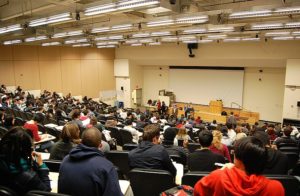
Most college students say their schools understand how to use education technology in the lecture hall, but only 9 percent of campus IT officials describe their institution’s technology adoption as “cutting edge,” according to a survey released July 19.
The survey of more than 1,000 IT staff members, faculty, and college students, conducted by CDW Government Inc. (CDW-G), shows that three out of four students surveyed approved of their college’s use of technology, while highlighting two findings that concerned some technologists: only a sliver of respondents defined their campus technology as “cutting edge,” and far more IT staffers push for education technology than do instructors.
According to CDW-G’s report, 47 percent of respondents said their college campus uses hardware that is “no more than three years old,” and 38 percent said their campus’s technology infrastructure is “adequate, but could be refreshed.” Only 9 percent said their education technology is “cutting edge,” and 5 percent described their computer systems as “aging.”
One percent of respondents said their institution’s technology is “in the dark ages.”
Thirty-one percent of college instructors said they considered web-based collaboration tools—programs that let students communicate with faculty and team up on projects from their home computers—to be “essential” parts of the modern classroom, while 72 percent of IT staff considered online collaboration critical in higher education.
IT staff members and campus instructors are more in agreement on the role of wireless internet access, with 65 percent of faculty saying wireless web is “essential” on campus and 87 percent of IT staff agreeing.
But the IT department and faculty members diverge on the role of recorded class lectures that allow students to watch professors’ lessons any time, anywhere—not just during class time. Nearly six in 10 IT staff support lecture capture technology, according to the survey, while just two in 10 instructors are in agreement.
Professors’ aversion to recording lectures and making them available on the web is no surprise to Jeremy S. Hyman, a longtime college educator and co-author of Professors’ Guide: The Secrets of College Success.
“[College faculty] want to resist technologies that replace the traditional classroom lecture,” Hyman said. “They want technologies that serve as a reasonable extension of their courses.”
That’s why instructors responding to the CDW-G survey were largely in favor of digital content for students, wireless web access, and smart podiums for lecture halls, Hyman said.
“Professors are skittish about recording and playing back lectures,” because once the lesson is made available on the internet, a college or university could claim it as the institution’s intellectual property and make faculty members expendable, he said.
Faculty members who have accepted the sage-on-the-stage lecture hall model, Hyman said, should be wary of lecture-capture technology.
“Once professors have that 400-person lecture, they’ve laid the groundwork themselves for the problem. Once you’ve stopped engaging students in a one-to-one mode, it’s a small step for a university to license the content and stream it to students on the other side of the pipe,” he said.
Aron Goldman, an adjunct faculty member of the University of Massachusetts Amherst campus, said the survey’s findings wouldn’t surprise many in higher education who have seen first-hand the divergent views of campus IT officials and instructors.
“Academics can be real curmudgeons,” he said. “Individualistic culture, course repetition, and the length of tenure careers make it pretty challenging for IT folks to win over faculty.”
The push to incorporate evolving technology into college courses, Hyman said, is needed in higher education, but the clash between technology staff members and professors often stems from IT departments’ wide-ranging advocacy for the latest and greatest in online tools.
“The IT people don’t really understand from the inside what it’s like to teach a course,” he said. “They are on board for a broad spectrum of technology, whereas professors and students are making more fine-grained distinctions.”
Ronald Yaros, an assistant journalism professor at the University of Maryland, said IT staffers will always advocate for most technologies that can be used in the classroom, but it’s up to instructors to evaluate each tool and decide if it improves or hinders teaching and course work.
“It takes additional effort to adapt existing course content, then assess the effectiveness of technology to deliver the content interactively,” said Yaros, who was among the earliest adopters of Apple’s iPad when it was released in April. “How does a tool improve learning and why? [This is] a question only professors can answer.”
Tammy Peery, chair of the English Department at Montgomery College’s Germantown, Md. campus, said educators should accept suggestions from IT staff members, but shouldn’t incorporate a new software or online program before they’re sure it will help their students learn more efficiently.
“Teaching with technology isn’t about being flashier or faster or even easier,” said Peery, Maryland’s distance educator of the year in 2009. “If we have those things, but student success suffers, we haven’t improved anything. Faculty want to ensure that the new technology actually improves student learning and that it’s accessible to the majority of students.”
Peery continued: “It makes sense that most faculty would want to make sure that this type of teaching and learning is viable before deciding that it is essential and relearning course design for a new format.”
CDW-G’s report also shows that little has changed in students’ most pressing concerns about how technology is used by their professors. About one-fourth of student respondents said the “biggest impediment” to improved classroom technology is their professors’ inability to use the devices and online programs.
Fourteen percent said professors simply “won’t use” technology that is available to them. Eighteen percent of IT staffers agreed.
Link:
CDW-G’s 21st Century Campus Report
- Research: Social media has negative impact on academic performance - April 2, 2020
- Number 1: Social media has negative impact on academic performance - December 31, 2014
- 6 reasons campus networks must change - September 30, 2014

Comments are closed.